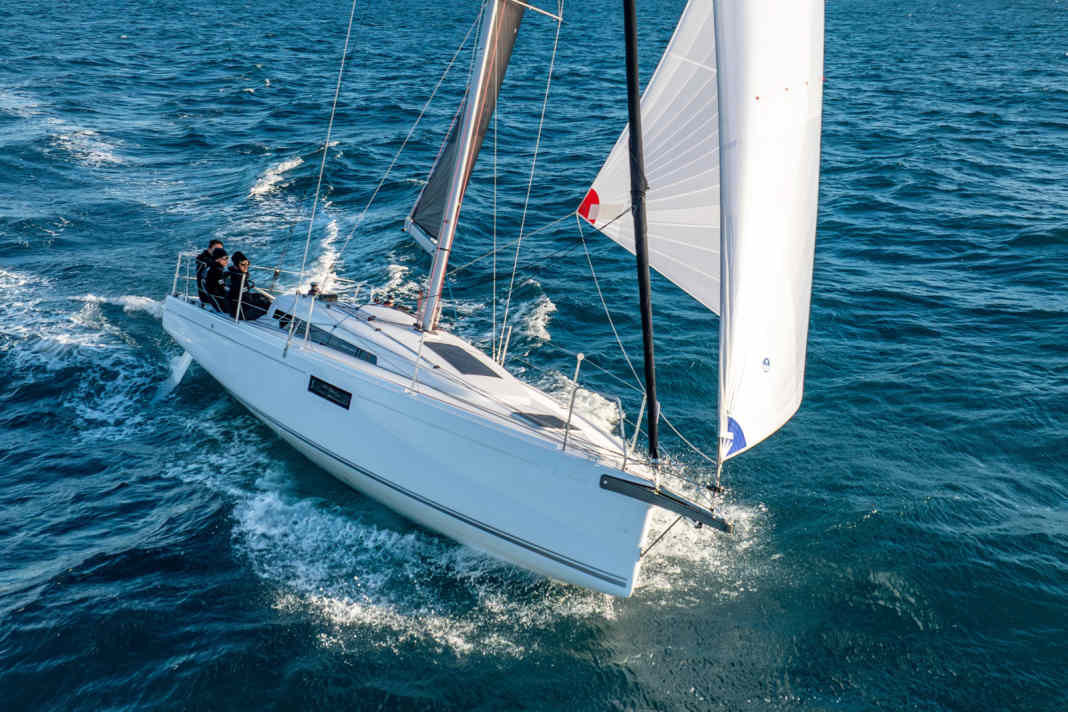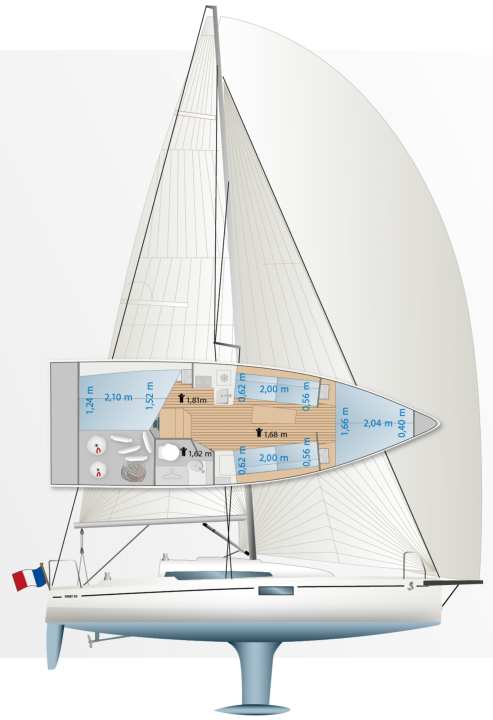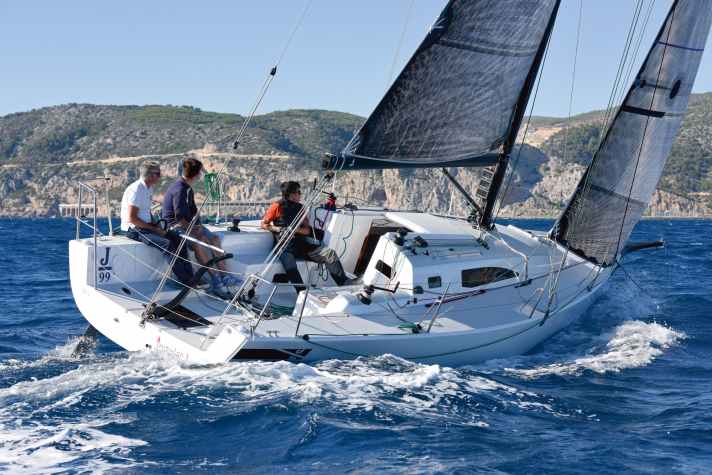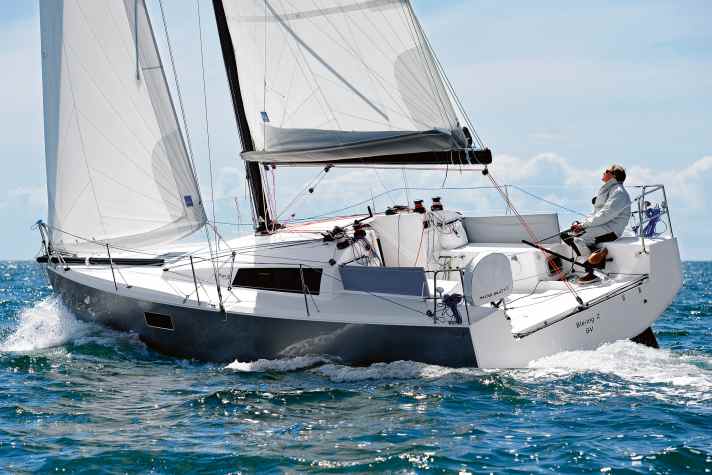Beneteau First 30: A gliding yacht with cruising qualities in the YACHT test
Michael Good
· 28.04.2025






Planing - that's a big word in sailing. It means that a boat moves so fast that it no longer ploughs through the water, but pushes itself out of its own wave system with its hull and glides on it - like a surfboard, for example. A boat that starts to glide produces less resistance than one that displaces. This means: more speed, more dynamics, more fun. For sailors, planing is therefore a state of happiness, joy and adrenalin. Only those who have experienced it know the fantastic feeling when the bow rises and the boat suddenly becomes very light and stable.
Read more about the shipyard:
Whether and when a boat can planing depends on many factors. Heavy and sluggish ocean-going yachts with a high ballast ratio, modest sail area and a pronounced V-frame are not built for planing. Even in strong winds, they will hardly ever reach this state. The situation is completely different for light sports boats, dinghies or racing yachts. With their generous sail plan and a flat hull design, they get planing faster. Thanks to modern, performance-optimised hull shapes and new lightweight construction technologies, planing is becoming an option for an ever wider range of boats.
becoming interesting for an ever wider range of boats. Even touring yachts are increasingly benefiting from this today.
Renaissance of the First series
An exciting development for which the industry giant Beneteau now even wants to establish a new category with its own name on the market: the "planning cruiser", i.e. the planing cruiser. These intentions are now to be realised with the new First 30. The new model for Beneteau's sporty First range sits between the First 24 sports boat and the First 36 performance cruiser and combines the advantages of both sisters. The concept of the First 30 is unusually open to compromise. You can actually do a lot with this boat, whether you want to go touring with the family, take a relaxed trip at the end of the day or take part in regattas with an active crew. The First 30 can serve as an attractive platform for almost any need.
The polyvalent orientation seems to be crowned with success. The shipyard has already received orders for 90 boats, 20 of them at the trade fair in Düsseldorf alone. And the aggressive pricing policy has undoubtedly also contributed to this. Beneteau announced a base price of 100,000 euros net at the project launch in September 2024 and has been able to keep this promise to this day.
Maximum weight reduction for gliding properties
Beneteau has been successfully working on the renaissance of the sporty First series in France for years. The current range now includes no fewer than eight models, from the 4.50-metre two-man dinghy to the 17-metre fast cruiser. Since 2018, the industry leader has been cooperating with the sports boat experts at Seascape in Slovenia, where all boats in the First line with a hull length of less than eleven metres are now developed and built - including the 30s, of course. The shipyard, based near the capital Ljubljana, builds all GRP parts as sandwich constructions using a complex vacuum infusion process and osmosis-resistant vinyl ester resin for the hull components.
The floor assembly is laminated together with the furniture foundations as one large, coherent and structurally load-bearing component and subsequently glued into the finished fuselage. This complex construction method ensures extremely rigid connections while maximising weight reduction. This, in turn, is relevant for the gliding ability of the First 30, as promised by Beneteau and Seascape.
Would the design from the collaboration between Sam Manuard and Lorenzo Argento really glide as fast as a sports boat? With this curiosity in mind, the YACHT editorial team travelled to Slovenia to test the boat.
Playful and light under sail
In the bay of Piran, a beautiful sea breeze sets in during the course of the sunny day, with winds of up to 12 knots. And indeed: with the almost 100 square metre top gennaker and a speed of around 9.5 knots, the full and flat bow gradually begins to push itself across the water. The crew can help to speed up the planing process by shifting their weight aft.
Measured values of the Beneteau First 30



With double-digit values on the log, the First 30 is almost at full planing speed. Playful and light, like a small dinghy, the boat can be steered under pressure, but also reacts immediately and strongly to the two rudder blades. The helmsman has to steer carefully, but at the same time retains full control. Nevertheless, the boat managed a record speed of 10.8 knots on the test day, and that in only moderate winds.
Even after the cross course, the overall impression remains positive. In particular, the turning angles of less than 80 degrees are surprisingly good for a boat of this size and orientation. The First 30 achieves a speed of 6.2 knots upwind. However, with an aspect ratio of 3.12, the comparatively slim design quickly takes on a lot of heel. This is in spite of the hard-sided hull transom, the comparatively deep standard T-shaped keel and a ballast ratio of 35 per cent.
One-handed suitability falls by the wayside
However, the First 30 remains stable on course even when deliberately heeling and makes no attempt to run off course. Quite the opposite. The helmsman can steer the boat with a pleasantly light rudder pressure very precisely and with a lot of dynamism on the windward edge, even when heeling more. The tiller steering, which is obviously very well tuned, also enhances the good steering feel.
Depending on the application and requirements, the shipyard offers various options for guiding the mainsheet. The standard arrangement is according to the German-Cupper principle via a sheet triangle aft to the mast and back to the winches on the coaming on both sides. The helmsman can easily operate these from his position, even single-handedly. Alternatively, a central mainsheet guide is offered via a traveller with tackle pull and fine adjustment, as on the test boat. The genoa sheets, on the other hand, are operated via the winches on the coachroof, but remain out of reach of the helmsman at the tiller. This deprives the First 30 of a certain single-handed capability, for example for use as a daysailer. Although an autopilot is available as an option, it can only help to a limited extent. And a self-tacking jib is not provided for the First 30.
However, there is a solution for soloists. If you often want to travel alone and have ordered the boat with a traveller and mainsheet, you could also guide the genoa sheets onto the rear winches with a few additional deflection blocks. Although this is not an option specified by the boatyard, it worked very well in the YACHT test.
The Z-Spars mast is made of aluminium as standard and is positioned conspicuously far aft, almost exactly in the middle of the measured waterline. The J-measurement remains correspondingly long and the sail area of the 106 per cent overlapping genoa is almost the same size as that of the mainsail. However, this also means that a backstay must be attached to control the sag in the forestay. In any case, a classic mainsail with a pin-head remains.
Functional below deck
Beyond the companionway, you are greeted by a very functional and unadorned interior. Nevertheless, the interior design surprises with a great sense of cosiness and an open, inviting spatial impression. This is helped by the fact that the entire saloon area is fitted with a continuous interior shell. As with the test boat, stylish fabric panelling is also available for the inside of the hull. The windows on the long superstructure remain narrow and short. The shipyard has also dispensed with an additional hatch in front of the mast in order to keep an area free for a solar panel to generate electricity. For this reason, it remains relatively dark below deck during the day, despite the large hull windows.
The berth in the aft cabin is bordered on the inside by the companionway and the engine compartment. This means that only one adult or the children can sleep well aft. On the other hand, the bunk in the forward cabin is all the more comfortable, even for double occupancy. The berth is over two metres long and an impressive 1.66 metres wide at the shoulders. The two sofas in the saloon can also be used as berths. Their back cushions can simply be folded outwards.
Storage space on board is in short supply, at least in the basic version. If you want to use the First 30 as a family boat, additional fabric storage compartments are available, which can be attached to the bulkheads forward and aft. A smart and lightweight solution, but one that comes at an additional cost. In addition, lightweight folding doors with magnetic catches are available for both the foredeck and the aft cabin, although these are also only available as options at an additional cost.
The wet room remains separate anyway and is more spacious than average for the size of the boat. Unfortunately, there is no storage space in the bathroom either. Instead, there is a large, open compartment with drainage for oilskins. And a hatch in the rear bulkhead allows direct access to the large port locker on the starboard side.
In terms of touring suitability, the First 30 scores points with its relatively large galley. Seascape installs the same module on the small boat as on the larger First 36, but omits the central kitchen block. Anyone cooking on board will therefore be pleased to have sufficient storage space, easily usable work surfaces and a large, deep refrigerator compartment. Because the design in the rear part of the saloon can do without the floor assembly, there is a standing height of 1.81 metres in the kitchen. In the companionway and galley area, you stand on the ridge 30 directly on the hull shell.
Prices of the Beneteau First 30
With a base price of 100,000 euros net, the First 30 is undoubtedly the absolute price breaker within its market segment.
- Base price ex shipyard: 119.000 €
- Price ready to sail: 135.900 €
- Guarantee/against osmosis: 3/7 years
Status 2025, how the prices shown are defined, read here!
It is surprising that the market leader Beneteau can maintain its extremely aggressive pricing strategy even after the market launch, especially considering the decent inventory in the basic version and the robust, high-quality construction.
At a time when the clear and compact boat concept, sportiness and performance are once again taking centre stage, Beneteau and Seascape are positioning themselves just right with their extremely versatile First 30. They are tapping into the current zeitgeist and appealing to a broadly diversified group of buyers who are once again placing greater emphasis on flexibility and performance.
YACHT review of the Beneteau First 30
It delivers what its concept promises. The First 30 is an extremely versatile sports boat in a handy size with plenty of potential and good touring capabilities.
Design and concept
Consistently willing to compromise
High-quality, robust construction
Attractive pricing
Sailing performance and trim
Sporty sailing characteristics
Efficient trimming devices
Not suitable for one-handed use
Living and finishing quality
Fully suitable for touring
Cosy interior design
Storage compartments only as an option
Equipment and technology
Impeccable basic equipment
Electric motor as an option
Few ventilation options
The Beneteau First 30 in detail

Technical data
- Design engineer: Sam Manuard
- CE design category: A
- Torso length: 9,35 m
- Total length: 10,33 m
- Waterline length: 8,75 m
- Width: 2,99 m
- Draught/alternative: 1,98/1,68 m
- Mast height above WL: 14,70 m
- Theoretical torso speed: 7.2 kn
- Weight: 3,04 t
- Ballast/proportion: 1,07 t/35 %
- Mainsail: 28,2 m²
- Furling genoa (106 %): 26,5 m²
- machine (Yanmar): 10 kW/14 hp
- Fuel tank (PVC): 40 l
- Fresh water tanks (PVC): 100 l
- Holding tank (PVC): 30
Hull and deck construction
GRP sandwich, laminated in a vacuum infusion process over a foam core with vinyl ester resin. Structural floor assembly glued in, bulkheads made of GRP composite, keel made of cast iron.
Motorisation
The two-cylinder built-in diesel from Yanmar (2YM15) with 15 hp, shaft drive and 2-blade folding propeller is standard. Alternatively, an electric drive from Kräutler with 5 kW power is available, also with shaft drive. The surcharge is approx. 9,700 euros.
Rig
Z-Spars double-stepped aluminium mast with 1:19 wire shrouds and backstay. A carbon fibre rig with the same dimensions is optionally available. However, prices have not yet been finalised.
Shipyard
Chantier Beneteau, 85850 Saint-Gilles-Croix-de-Vie (France); www.beneteau.com
Distribution
Dealer network
Competition from the Beneteau First 30
The competition is broad-based. There are offers for every requirement.
J/99

Powerful performance cruiser with a strong regatta focus. The boat is highly customisable, depending on use and dimensions. Sober, yet cruising-ready interior. Hull length 9.94 m; width 3.40 m; weight 3.8 tonnes; from 172,830 euros. Read the J/99 test here.
Pogo 30

The design for the sporty Frenchwoman comes from Finot-Conq and is significantly wider than competing boats. The Pogo 30 is available with a fixed keel and lead bomb or with a swivelling keel. Hull length 9.14 m; width 3.70 m; weight 2.8 tonnes; from 165,700 euros. Read the test of the Pogo 30 here.
Pointer 30

Attractive crossover boat from Holland with an unusually wide range of uses. In the test, the boat showed good, dynamic sailing characteristics on all courses. Many variants for the interior fittings. Hull length 9.20 m; width 2.90 m; weight 2.4 tonnes; from 152,340 euros. Read the test of the Pointer 30 here.
RM 970

An exciting alternative with a plywood hull and a GRP deck. Several keel variants are possible. Attractive, spacious interior below deck. Beautifully built and equipped to a high standard. Hull length 9.70 m; width 3.70 m; weight 4.1 tonnes; from 219,610 euros. You can read the test of the RM 970 here.
ADVERTISEMENT

Insure Beneteau First 30 from 840.01 euros per year* - liability and hull. Many options available. Interesting for sports sailors: Regattas also insured. Simply calculate online and take out cover: yachting24.de
* Yachting24 offer valid for a sum insured of 119,000 euros (with current value cover), excess: 1,000 euros, liability cover: 8 million euros.

